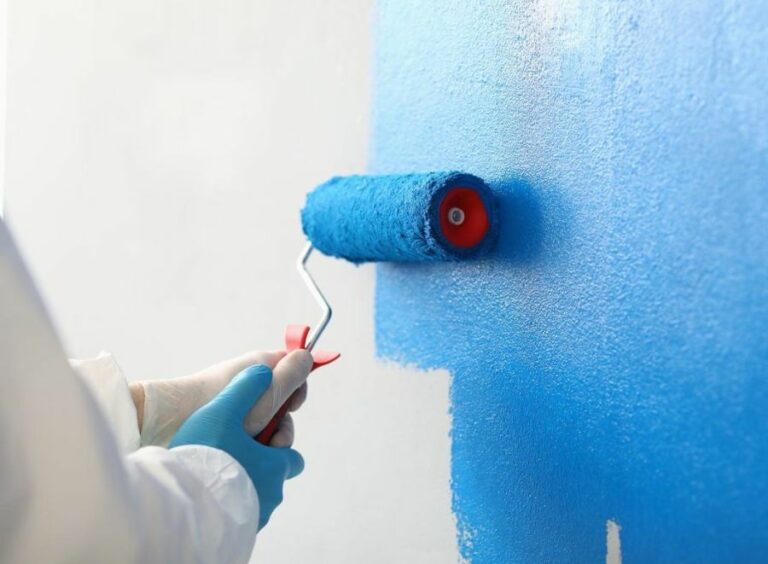Sanding And Scraping Techniques For Smooth Paint Application
Are you ready to transform your space with the perfect paint job but can’t seem to achieve that smooth finish you’ve been longing for? Look no further! We have the best sanding and scraping techniques to ensure a flawless paint application every time. By following these expert tips, you’ll save time and elevate your DIY skills to a professional level.
Sanding and scraping techniques for smooth paint application:
To achieve a smooth paint finish, proper surface preparation is essential. Begin by scraping away loose paint, dirt, or debris using a scraper or putty knife. Then, sand the surface with sandpaper or a sanding sponge, starting with a low grit for rough surfaces and moving to a higher grit for a smoother finish. Clean the surface, mask off areas to remain unpainted, and apply primer or paint.

Discover the secrets to achieving a flawless finish on your next painting project with our expert guide on sanding and scraping techniques. Smooth surfaces = smooth paint application. Keep reading to elevate your skills and impress with professional results!
Contents
- 1 Techniques for Achieving a Smooth Paint Finish with Sanding and Scraping
- 2 Achieving a Smooth and Even Paint Application: Tips and Tricks
- 3 Mastering the Art of Sanding for a Flawless Paint Finish
- 4 Ultimate Guide to Selecting the Perfect Sandpaper for Paint Smoothing
- 5 Essential Pre-Painting Sanding Tips for a Silky Smooth Finish
Techniques for Achieving a Smooth Paint Finish with Sanding and Scraping
• Importance of Proper Surface Preparation
Before embarking on any painting project, it is crucial to prepare the surface correctly to ensure a beautiful and long-lasting finish. One of the most vital aspects of surface preparation is creating a smooth and even surface through sanding and scraping.
• Tools Needed for Sanding and Scraping
To achieve a smooth surface for your paint application, you will require various tools, such as:
- Sandpaper or sanding sponges
- Sanding block, electric sander, or orbital sander
- Scrapers, putty knives, or paint scrapers
- Masking tape
- Primer or paint
– Choosing the Right Sandpaper
Using the right type of sandpaper or sanding sponge is essential for obtaining desired results. The two main factors to consider when selecting sandpaper or a sanding sponge include grit number and type of abrasive material.
- Grit number: The higher the grit number, the finer the sandpaper and the smoother the finish that can be obtained. For initial surface preparation, it is a good idea to use a lower grit, such as 80 or 100, for rough surfaces. Move on to higher grit numbers like 150 or 220 for a smoother finish before the final paint application.
- Abrasive material: Common abrasive materials include aluminum oxide, garnet, and silicon carbide. Aluminum oxide is durable and works well on wood surfaces, while garnet is suitable for hand sanding and works best on wood or other soft materials. Silicone carbide is ideal for wet sanding, paint removal, or working on metal surfaces.
• Scraping Techniques
Scraping involves removing loose or peeling paint, dirt, or other imperfections from the surface using a scraper, putty knife, or a similar tool.
Hold the scraper at an acute angle and apply even pressure as you scrape away the old paint, dirt, or debris. Take care not to gouge the surface, as this can create unevenness in the final paint application.
– Keep Safety in Mind
When working with sharp tools or using ladders to reach high places, it is essential to take caution and wear appropriate protective gear. Protective clothing, gloves, goggles, and masks should be worn to minimize the risk of injury and reduce exposure to dust and debris.
• Sanding Techniques
After removing loose paint and debris through scraping, you can begin the sanding process to create an even and smooth surface for paint application.
– Hand Sanding
While time-consuming, hand sanding is an effective method for smaller surfaces or intricate details.
To sand by hand, wrap a piece of sandpaper around a sanding block and move the sandpaper over the surface using a circular or back-and-forth motion. Keep the pressure even, and be sure to change the sandpaper frequently as it becomes worn.
– Electric Sanders and Orbital Sanders
An electric sander or orbital sander can be used for larger areas and faster results. These power tools should be used with caution and should only be used by individuals comfortable with their operation.
- Electric sanders move in a back-and-forth motion and are ideal for covering large swaths of surface quickly.
- Orbital sanders move in a circular motion, which is helpful for smoothing out intricate or curved surfaces.
• Final Surface Preparation Steps
After the sanding and scraping process, it is essential to clean and dust the surface before applying paint. Use a clean cloth or tack rag to remove any remaining dust or debris. Vacuum the surrounding area to ensure a clean work environment.
– Masking and Priming
Mask any areas that should not be painted using masking tape or painter’s tape. Apply a coat of primer to the prepared surface if necessary.
Primer helps the paint adhere better and provides a smoother finish. Many paint products on the market today are a combination of primer and paint, which can save time in the painting process.
• In Conclusion
Sanding and scraping techniques play a vital role in creating a smooth surface for paint application. By taking the time to prepare properly, you can achieve a beautiful, long-lasting finish.
Achieving a Smooth and Even Paint Application: Tips and Tricks
A smooth paint application can make all the difference in the final appearance of a painted surface, whether it’s walls, furniture, or any other object.
• Selecting the Right Paint
The first step in ensuring a smooth finish is to select the appropriate paint. High-quality paints tend to adhere better, self-level more effectively, and have fewer impurities, resulting in a smoother finish. When selecting paint, opt for one with a high viscosity rating and excellent leveling properties.
The U.S. Environmental Protection Agency offers recommendations on choosing low VOC (volatile organic compound) paint, which can also contribute to a smoother application.
– Understanding Sheen Levels
Paint sheen levels can also have an impact on the smoothness of the application. Glossy paints tend to show surface imperfections more than matte or satin finishes.
When aiming for a smooth application, consider choosing a paint with a lower sheen level, such as an eggshell or satin finish. These can help to minimize the appearance of minor surface imperfections.
• Proper Surface Preparation
One of the most critical factors in achieving a smooth paint application is proper surface preparation. This step is essential and should not be skipped, as it ensures a smooth and even surface for the paint to adhere to.
– Cleaning the Surface
Start by cleaning the surface thoroughly to remove any dirt, dust, or grease. Use a mild detergent and water solution with a non-abrasive sponge or cloth. After cleaning, ensure that the surface is completely dry before proceeding to the next step.
– Sanding the Surface
Lightly sanding the surface is a key step in achieving a smooth finish. Sanding helps to remove surface imperfections, such as bumps or rough spots, ensuring an even application.
Use fine-grit sandpaper (e.g., 220 or 240 grit) and sand evenly in a circular motion. After sanding, wipe the surface with a damp cloth to remove any dust or debris.
– Repairing Surface Imperfections
If there are any holes, cracks, or other imperfections in the surface, use a filler or patching compound to repair them. Apply the filler according to the product instructions and allow it to dry fully. Once the filler is dry, sand the area smoothly using fine-grit sandpaper.
– Priming the Surface
Priming the surface is essential for a smooth paint application, as it helps to even out the surface’s porosity and creates better paint adhesion. Use a high-quality primer that is suitable for the surface you are working on.
Apply the primer evenly, following the manufacturer’s instructions, and allow it to dry fully before painting. This step will ensure a smooth, even base for your paint.
• Choosing the Right Application Tools
The tools you choose for your painting project can significantly impact the smoothness of your paint application. Investing in high-quality tools will help to ensure a smoother finish.
– Brushes and Rollers
High-quality brushes and rollers will hold more paint and provide a more even application. Synthetic brushes, such as those made from nylon or polyester, are an excellent choice for water-based paints. They hold their shape well and provide a smooth finish.
When selecting a roller, opt for one with a short nap (e.g., a 3/8-inch nap) to ensure a smooth application. Be sure to choose a roller cover made from high-quality materials, such as microfiber or lambswool, for the best results.
– Paint Sprayers
For larger projects or for those who prefer a spray application, paint sprayers can offer an exceptionally smooth finish. When using a paint sprayer, ensure that it is clean and in proper working order.
Additionally, practice your spraying technique and adjust the sprayer settings as needed to achieve a smooth, even application.
• Proper Painting Techniques
Even with the right tools and surface preparation, proper painting techniques are crucial for a smooth paint application.
– Stirring the Paint
Before applying the paint, stir it thoroughly to ensure a consistent texture and color. Stirring helps to redistribute any settled pigments and solvents, resulting in a smoother application.
– Using the Right Amount of Paint
Overloading your brush or roller can lead to drips, runs, and uneven application. Dip your brush or roller into the paint, and then remove the excess by tapping or rolling it on the side of the paint container. This will help to ensure an even distribution of paint on the tool and minimize the risk of drips and runs.
– Applying Paint in Thin Coats
Applying thin coats of paint, rather than trying to achieve full coverage in one coat, will result in a smoother finish. Allow each coat to dry fully before applying the next one. This will help to ensure proper adhesion and a more even finish.
– Keeping a Wet Edge
When painting, maintain a wet edge by overlapping each paint stroke or roller pass with the previous one. This technique will help to prevent any visible lines or streaks and create a smooth, seamless finish.
• Final Thoughts
Achieving a smooth paint application requires attention to detail, patience, and practice.
By following the steps outlined in this article selecting the right paint, preparing the surface, using high-quality tools, and applying proper painting techniques, you will be well on your way to a beautiful and smooth paint finish in your next project.
Mastering the Art of Sanding for a Flawless Paint Finish
A smooth paint job can make all the difference in the appearance and quality of a finished project. One essential step in achieving this pristine finish is to properly sand the paint. The following guide will discuss the process, techniques, materials, and tips for sanding paint to achieve the desired smooth finish.
• Importance of Sanding Paint
Sanding paint serves multiple purposes, such as removing imperfections, creating an even surface, and promoting adhesion for subsequent coats of paint. Without proper sanding, the surface may have visible defects or fail to properly bond with additional layers of paint.
• Selecting the Right Sandpaper
Choosing the appropriate type of sandpaper is crucial for achieving a smooth finish. Sandpaper comes in various grits, which refers to the number of abrasive particles per square inch. Lower grit numbers indicate coarser sandpaper, while higher grit numbers correspond to finer sandpaper.
– Coarse Sandpaper (60 – 80 Grit)
Coarse sandpaper is best for removing old paint or varnish, rough surfaces, and heavy imperfections. However, using too coarse of sandpaper can create grooves and scratches on the surface, making it difficult to achieve a smooth finish.
– Medium Sandpaper (100 – 150 Grit)
Medium sandpaper is suitable for most general-purpose applications, such as preparing surfaces for painting and light sanding between coats of paint. This grit can help remove minor imperfections without causing significant damage or creating deep scratches.
• Proper Sanding Techniques
– Dry Sanding
Dry sanding is the most common technique for sanding paint, as it can be used with almost any paint type. The process entails using sandpaper without any water to remove material from the painted surface.
- Select the appropriate sandpaper grit based on the surface’s condition.
- Apply even pressure while moving the sandpaper in a circular or back-and-forth motion. Avoid applying too much pressure to prevent gouging the surface.
- Periodically clean the sandpaper and surface with a soft cloth or brush to remove accumulated dust.
– Wet Sanding
Wet sanding involves using water to lubricant the sanding process, which can help reduce dust and prevent clogging of the sandpaper. This technique is typically reserved for water-based paints or clear coats, as it can cause damage to other types of paint.
- Choose a high-quality waterproof sandpaper designed for wet sanding.
- Soak the sandpaper in water for at least 5 minutes before beginning.
- Wet the surface to be sanded with a sponge or spray bottle.
- Sand the surface using light, even pressure, while keeping the sandpaper and surface wet. Frequently rinse the sandpaper in water to remove buildup.
– Using a Sanding Block or Power Sander
For larger projects, using a sanding block or power sander can help achieve a more consistent and even surface. However, be cautious when using power tools to prevent causing damage or removing too much material from the surface.
• Tips for Sanding Paint
– Start with a Clean Surface
Before beginning the sanding process, ensure that the surface is clean and free of any dirt, debris, or grease. This will prevent the sandpaper from becoming clogged and reduce the risk of damage to the surface.
– Sand in Stages
Begin with a coarser grit to remove imperfections, and gradually work your way to finer grits for a smoother finish. Skipping steps can leave behind fine scratches or result in an uneven surface.
– Protect Yourself
Wear appropriate safety gear, such as gloves, goggles, and a dust mask, to protect against potential hazards and dust inhalation.
– Test a Small Area
Before sanding the entire surface, test your chosen sandpaper and technique on a small, inconspicuous area to ensure the desired results.
• Finishing Touches
After the sanding process is complete, wipe down the surface with a tack cloth or damp cloth to remove any remaining dust or debris. Ensure that the surface is completely dry before applying any additional coats of paint or sealant.
Achieving a smooth finish by sanding paint is an essential part of creating a polished and professional-looking result. By selecting the appropriate sandpaper, utilizing proper techniques, and following these guidelines, your paint job will have the desired finish and lasting quality.
Step | Instructions |
|---|---|
1 | Choose the appropriate sandpaper grit. Start with a higher grit (150-180) for rough surfaces. On smooth surfaces or between coats, use fine-grit sandpaper (220-240). |
2 | Put on safety equipment such as gloves, goggles, and a dust mask before starting. |
3 | Attach the sandpaper to a sanding block for better control and even pressure. |
4 | Lightly sand the surface using even, circular motions. Apply consistent, gentle pressure without pressing too hard to avoid gouging the surface or removing too much paint. |
5 | Periodically wipe away dust and debris with a clean cloth. |
6 | When the surface feels smooth to the touch, stop sanding. |
7 | Remove any remaining dust with a tack cloth, vacuum, or soft brush before applying the next coat of paint. |
Ultimate Guide to Selecting the Perfect Sandpaper for Paint Smoothing
Selecting the ideal sandpaper for smoothing paint is crucial to achieving a perfect finish. Various factors, such as the type of paint, surface material, and purpose, must be considered in the decision-making process.
• Understanding Sandpaper Grit
The effectiveness of sandpaper is mainly determined by its grit: the number of abrasive particles per inch. The higher the grit number, the finer the particles and the smoother result on the surface.
– Coarse Grit
Coarse grit sandpaper (40-60 grit) is not suitable for paint smoothing projects because it is primarily intended for removing large amounts of material quickly.
– Medium Grit
Medium-grit sandpaper (80-120 grit) is an excellent choice for smoothing paint. It is ideal for removing noticeable imperfections on painted surfaces without causing too much damage to the underlying material.
– Fine Grit
Fine-grit sandpaper (180-240 grit) is perfect for providing a final smooth finish on painted surfaces. It is particularly suitable for use on wood surfaces, as it can eliminate even the smallest scratches.
– Extra Fine Grit
Extra fine grit sandpaper (320-600 grit) is typically used for sanding between coats of paint and achieving a polished, ultra-smooth finish. This type of sandpaper is ideal for use on materials like metal, plastic, or fiberglass.
• Sandpaper Material Types
In addition to the grit size, the material used to create the abrasive particles in sandpaper is a significant factor in determining its performance. Let’s take a look at the most common types of sandpaper materials.
– Aluminum Oxide
Aluminum oxide sandpaper is tough, durable, and an excellent choice for general-purpose paint smoothing. It can be used on wood, metal, and plastic, making it very versatile.
– Silicon Carbide
Silicon carbide sandpaper is a very fine abrasive, making it ideal for wet or dry sanding. It’s excellent for use on materials like wood, metal, plastics, and fiberglass. The flexibility of the silicon carbide particles also makes it particularly helpful when used on curved surfaces.
– Ceramic
Ceramic sandpaper is typically found in the form of belts or discs and is primarily used with power tools. It is a durable, long-lasting option that can handle prolonged use, and intense heat, making it suitable for heavy-duty paint removal or surface preparation.
• Recommended Sandpaper Types for Specific Paint Smoothing Tasks
Based on my experience, the following recommendations are provided for specific paint-smoothing tasks:
– Paint Removal
For paint removal, I recommend using medium grit (80-120) aluminum oxide sandpaper. It is tough and can handle heavier paint layers, providing a smooth surface for repainting.
– Smoothing Between Coats
When smoothing between coats, opt for a fine (180-240 grit) or extra fine (320-600 grit) silicon carbide sandpaper. Its gentler nature is perfect for ensuring a pristine surface for the next coat of paint.
– Wet Sanding
For wet sanding, select extra fine (320-600 grit) silicon carbide sandpaper. Its waterproof properties ensure it remains effective even when wet. Wet sanding can help achieve a very smooth finish and is particularly useful on automobiles or furniture.
– Curved Surfaces
For curved surfaces such as moldings or trim, a flexible silicon carbide sandpaper in fine (180-240 grit) is the best option. Its adaptability allows it to conform to the curved surface, providing a smooth finish.
• Additional Sanding Tips
- Always sand in the direction of the grain when using wood. This practice helps to prevent scratches and ensures a smooth finish.
- Use a sanding block or pad to give even pressure to the sandpaper, providing consistent results.
- Replace sandpaper as it becomes worn or clogged to maintain its effectiveness.
• Conclusion
In conclusion, the key to a perfect paint finish is selecting the right sandpaper based on the specific task, surface material, and desired end result.
Aluminum oxide and silicon carbide sandpapers are the most effective choices for smoothing paint while considering factors such as grit size and flexibility. With these tips and recommendations, any paint smoothing project can achieve professional-looking results.
For further information on selecting the ideal sandpaper, visit this page from the Purdue University website, which provides valuable insight into the appropriate sandpaper choices for different tasks.
Type | Grit | Description | Usage |
|---|---|---|---|
Aluminum Oxide | 180-220 | Durable and long-lasting, this sandpaper is ideal for smoothing paint. | Use lightly on painted surfaces to create a smooth finish. |
Garnet | 220-320 | Natural and less aggressive, garnet sandpaper is suitable for use on delicate surfaces. | Use carefully on painted surfaces for a fine finish, without damaging the paint. |
Silicon Carbide | 320-400 | With a waterproof property, silicon carbide sandpaper supports wet sanding which helps prevent clogging. | Use wet on painted surfaces for ultra-smooth finishes and removing minor imperfections. |
Essential Pre-Painting Sanding Tips for a Silky Smooth Finish
A smooth and well-prepared surface is crucial for a flawless paint job. As an experienced painter and decorator, I understand the importance of proper surface preparation, which includes sanding.
• Importance of Surface Smoothness
A smooth surface ensures even paint application, prevents uneven absorption of paint, gives a professional finish, and enhances the durability of the paint job.
Sanding before painting removes imperfections, creating a uniform surface for the paint to adhere to. It also reduces the chances of paint chipping, peeling, or flaking over time.
• Identify the Surface
The first step in the sanding process is to inspect the surface you plan to paint. The type of material and its condition plays a significant role in determining the level of smoothness required. Some common surfaces include:
- Wood
- Drywall
- Plaster
- Metal
Each of these materials requires a different approach to achieve the desired level of smoothness.
– Wood
Raw, unfinished wood typically has a rough surface that needs sanding for optimal paint adherence.
Start with coarse-grit sandpaper (60 to 80 grit) to remove surface imperfections, and gradually work your way to finer grits (120 to 220 grit) to achieve the desired level of smoothness. (How to Prepare Wood Trim for a Smooth Paint Job)
For painted or varnished wood, use medium-grit sandpaper (80 to 120 grit) to remove the gloss, followed by fine-grit (150 to 180 grit) for a smooth finish. Wipe the surface with a tack cloth to remove any residual dust before priming and painting.
– Drywall
For new drywall or patches, it is essential to feather out the joint compound edges using a fine-grit sandpaper (120 to 150 grit). This minimizes the visibility of seams while ensuring a uniform surface for painting. When sanding existing painted walls, use medium-grit sandpaper (80 to 120 grit) to remove any rough spots, imperfections, and gloss, followed by fine-grit (150 to 180 grit) for a smooth finish.
– Plaster
Sanding plaster walls can be challenging due to their uneven texture. Start with medium-grit sandpaper (80 to 120 grit) to knock down any high spots or rough areas. Then, use fine-grit sandpaper (150 to 180 grit) to achieve a smoother surface. Wipe the surface with a damp cloth to remove any dust before priming and painting.
– Metal
For metal surfaces, rust and any old paint must be removed before sanding.
Start with coarse-grit sandpaper (60 to 80 grit) to remove any remaining paint, then use medium-grit sandpaper (80 to 120 grit) to smooth out any imperfections, and finally, use fine-grit sandpaper (150 to 180 grit) for a polished finish.
If possible, use a wet-sanding technique to minimize metal dust and ensure a smoother surface. This technique involves soaking the sandpaper in water before sanding.
• Sanding Tips and Techniques
Here are some useful tips and techniques to achieve the desired level of smoothness:
- Direction: Sand in the same direction as the wood grain to minimize scratches and achieve a uniform surface.
- Check progress: Periodically examine the surface for rough spots, sanding marks, or imperfections using your fingertips and adjust your sanding technique accordingly.
- Change sandpaper often: As sandpaper becomes worn, its effectiveness decreases. Replace it regularly for optimal results.
- Use a sanding block: A sanding block ensures even pressure across the entire surface, resulting in a smoother finish.
- Moderate pressure: When sanding, apply consistent, moderate pressure. Too little pressure leaves imperfections, while excessive pressure can cause uneven surfaces or damage the material.
- Clean the surface: Use a vacuum or tack cloth to remove dust and debris after sanding, as lingering particles can affect paint adhesion and create a rough finish.
In conclusion, the level of smoothness required before painting depends on the material and its condition. Achieving the optimal level of smoothness involves using appropriate sandpaper grits and employing proper sanding techniques.
Following the recommendations in this article will help you create a stunning paint job that lasts.







